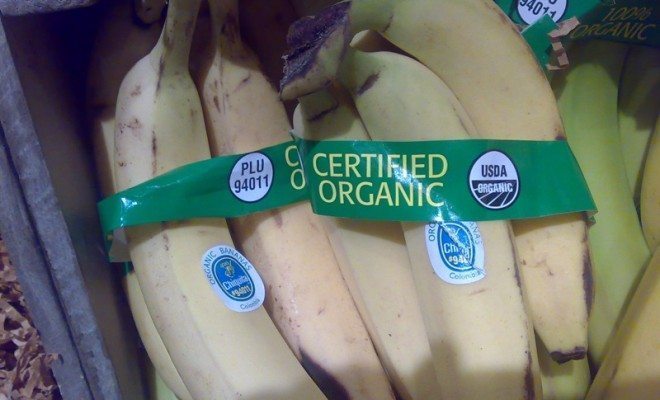 Image courtesy of [Paul Swansen via Flickr]
Image courtesy of [Paul Swansen via Flickr]
Health & Science
What’s in Your Food?: A Look at Regulating the Food Industry
A recent report from several environmental consumer advocacy groups graded of 25 of the leading fast food restaurants on the use of antibiotics in the meat they use, and for anyone concerned with the use of antibiotics in the food supply the results are illuminating. The report yielded some surprising ratings for America’s most popular fast food restaurants, giving only two an A grade.
We often hear about the use of things like antibiotics, hormones, and other additives in our food, but not everyone knows exactly what effects they have on our health. Read on to learn more about what’s in your food and what’s being done to make sure everything we consume is healthy.
Antibiotics
When most people think about antibiotics the first thing that comes to mind is the medicine you get for strep throat or ear infections, so how are antibiotics important in terms of what we eat? The answer lies at the beginning of the food production, when farmers raise livestock for food.
The purpose of antibiotics is to kill harmful bacteria, which is important for both humans and for animals in the food supply. The problem is that they do not necessarily kill all the bacteria. For example, they may kill 99 out of 100 bacteria cells. However, the one percent that survives is immune to the antibiotic and reproduces. Over time, the resistant bacteria can reproduce, making the antibiotic no longer effective, which mean that a stronger medicine is needed to kill the bacteria. Resistant bacteria may also be transmitted to humans during consumption, which can lead to significant health concerns. The growing population of resistant bacteria could pose a significant health risk as antibiotics become less and less effective.
Farmers treat their animals with antibiotics for several reasons, but most importantly they do it because they want to keep the animals healthy. The use of antibiotics has also led to larger and heavier animals, which also means more profit. The central issue with the use of antibiotics in livestock is the fact that they are used when they are not actually needed. While few argue that antibiotics should never be used on animals, the use of “sub-therapeutic” doses, which are given when an animal is not sick is what most people have a problem with. Over time, these doses lead to resistant bacteria, which may be transferred to humans when consuming meat.
FDA regulations instruct farmers to use antibiotics only when an animal is sick or if there is an unusually high risk of disease, but that is not always the case. According to the Friends of the Earth and National Resource Defense Council mentioned above, 70-80 percent of the antibiotics used in the United States are given to animals. The report found that 20 of the top 25 fast food chains received a failing grade for their antibiotics policies.
Hormones
Like antibiotics, hormones are used to make animals bigger and stronger. But the hormones contained in the meat that people eat is passed along to humans as well. The FDA approves and regulates all hormones that are used in food production. The amounts allowed in food are determined by the FDA through research and are supposed to be well below the levels that naturally occur in the human body, thereby preventing any negative effects.
When it comes to hormones, there are a lot of gray areas in terms of their health effects. The two largest concerns associated with their use are a possible increased risk of cancer and the early onset of puberty in children. Existing studies suggest that lifetime exposure to hormones like estrogen can be linked to greater risk of cancer, and hormones previously used in animals have actually been tied to cancer risk. Diethylstilbestrol (DES), was a used in the 1960s and was connected to heightened risk of certain forms of cancer, but DES use ended after this connection was discovered. The amount of estrogen present in food is significantly lower than levels that naturally occur in our bodies. Currently, there is not sufficient evidence to draw a clear connection between growth hormone use in animals and an increased risk of cancer. Hormones given to animals are essential for growth and development, and the FDA regulates them to ensure that their presence in our food remains at safe levels. According to the FDA:
People are not at risk from eating food from animals treated with these drugs because the amount of additional hormone following drug treatment is very small compared with the amount of natural hormones that are normally found in the meat of untreated animals and that are naturally produced in the human body.
One issue that has a stronger connection to the use of hormones in the food supply is the early onset of puberty in children. On average, children have been starting puberty earlier than in the past, which some scientists have linked at least in part to the presence of hormones in food. While food still has relatively low levels of these hormones, their mere presence can cause children to reach puberty earlier. Although studies have found a connection, the use of hormones, like most many food-related health issues, still requires further research to clarify the link.
Pesticides
While antibiotics and hormones are designed to fatten animals, pesticides serve a similar purpose for fruits and vegetables. Pesticides do not increase the size of fruits or vegetables, but they do help ensure their survival from threats such as insects or weeds. They also kill potentially harmful organisms such as mold or fungus which can grow on foods.
Due to the widespread use of such chemicals on most foods the EPA and similar organizations in other countries have set tolerances for the amount allowed in foods. These tolerances are set after conducting risk assessments, which look at the potential health risks of individual pesticides. Once the tolerance has been set, it is then enforced by the USDA and FDA, or a corresponding agency in another nation. Yet several questions remain about the use of pesticides as well as their effects on humans and the environment. Pesticides are not allowed to be used on foods until they have gone through an assessment and they are also occasionally re-evaluated to make sure the set tolerance is appropriate. Re-evaluating pesticides is the primary way to address issues with tolerances and new information about health effects.
Preservatives
Preservatives, like other food additives, are in foods to serve a purpose beyond increasing profits, but they also come with their own risks. Generally speaking, the purpose of preservatives are to make food last longer and prevent rotting.
While preservatives help keep things fresh, they may also harm the people who ingest them. A recent study by immunologists at Georgia State University found that pesticides can erode a protective lining in the colon, which can lead to inflammation and even change the nature of bacteria located there. This has been linked to higher rates of inflammatory bowel disease and obesity.
Preservatives are regulated by the FDA, which has the final say on which additives are approved for consumption. While the FDA regulates the use of preservatives, most additives are never actually tested by the FDA. This is because the FDA uses the GRAS labeling system for many things that are added to food. GRAS, an acronym for the term “Generally Recognized As Safe,” allows producers to add things to food according to established practices, but without requiring pre-approval from the FDA. While this system expedites the rate at which new products can go on the market, there have been several instances where the FDA approved the use of a certain additive, only to repeal it later when they proved to be carcinogenic. Examples of this include Cyclamate, Safrole, Saccharine, and most recently, trans fats.
The video below looks at a variety of food additives and their uses:
The Future of Food
Organic Food, Buying Local, and Farmer’s Markets
According to the United States Department of Agriculture (USDA), organic food is “produced without antibiotics, hormones, pesticides, irradiation or bioengineering.” By its very definition then, organic food has the potential to alleviate many of the alleged effects of added ingredients simply because it does not have them. What’s more, becoming certified organic by the USDA is a long, difficult, and expensive process. As a result, the validity of this label also comes with a certain amount of clout. In 2014, the combined sales of organic food in the United States was up 11.3 percent from the previous year to $39.1 billion, approximately five percent of the entire food market.
The rise in organic food sales can, at least in part, be associated with the rise in farmers’ markets. Between 2006 and 2014 the total number in America rose 180 percent to 8,268. Farmers are also turning to selling to local restaurants, distributors and even directly to local schools. Aside from offering food that does not contain any of the additives listed above, doing so has the added impact of reducing fuel costs and pollution.
The Food Industry
Another major change is on the part of the traditional food industry, from grocery stores to restaurants. With organic food emerging as a major trend, supermarkets have been quick to respond. Chains such as Whole Foods have been some of the most successful stores, as their businesses operate on the notion of selling these types of foods.
Fast food, on the other hand, is under a tremendous amount of pressure to use healthier food with fewer additives. The industry has taken some important steps, but based on evaluations like the report mentioned at the beginning of this piece, it has a long way to go. Even before the release of that report, efforts had been underway to rid menus of additives, GMOs, and the equally demonized high-fructose corn syrup. Industry leaders like Panera and Chipotle stopped using these ingredients in their food long before the issue came back up in the news.
Like the use of additives, organic foods also have their own costs and benefits. The first is price–organic food is notoriously more expensive than its non-organic counterparts, as are the prices in restaurants that serve them. Additionally, it is still unclear if they offer any more nutritional value than non-organic foods beyond the absence of additives, hormones, and pesticides. The following video details the pros and cons of organic food:
Conclusion
When people eat food that has antibiotics, hormones, or preservatives, these additives become part of the body and may have adverse effects on their health. We have recently taken important steps to understand what exactly goes into our food and how that affects our health, but there is still a lot that remains unknown. Buying organic food and trying to reduce the use of pesticides and certain additives is an important step to ensure that everything we consume is healthy. But taking these steps to monitor what we eat is only part of the equation; we also need more research to determine exactly how our bodies react to various things that are added to what we eat. While the FDA, USDA, and EPA regulate food production to ensure pesticides, additives, and hormones do not exceed safe levels, these regulations evolve with research. It is up to every individual to make their own informed choice based on their own means. When choosing food people should identify what goes into what they consume and how it is produced. As research progresses, recommendations and regulations can and will continue to change.
Resources
Primary
FDA: Steroid Hormone Implants Used for Growth in Food-Producing Animals
Additional
CNN: Report Examines Antibiotics in Meat on Fast Food Menus
Nature: Food Preservatives Linked to Obesity and Gut Disease
Organic Trade Association: U.S. Organic Industry Survey 2015
NPR: Are Farmers’ Market Sales Peaking? That Could be a Good Thing for Farmers
Health: America’s Healthiest Grocery Stores
Entrepreneur: 7 Major Restaurants That are Getting Rid of Artificial Ingredients
Organic Consumers Association: Beef, Hormones Linked to Premature Onset of Puberty & Breast Cancer








Comments